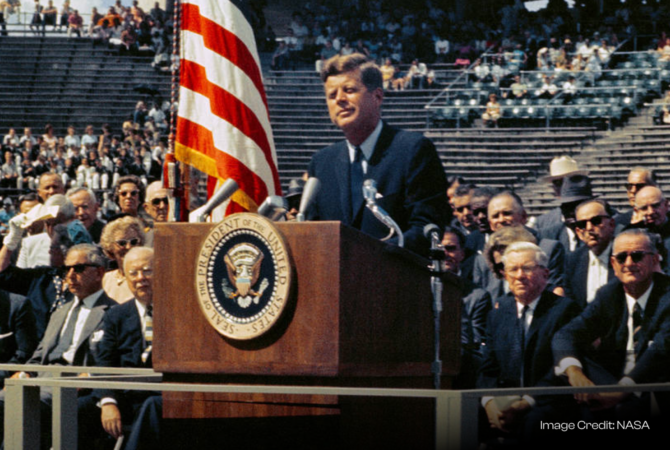Media Mentions
SCSP Announces New Sponsors – a Delegation from South Dakota, as well as NobleReach Foundation and With Honor Action – Joining SCSP’s AI Expo for National Competitiveness
Special Competitive Studies Project
Insights
Ask most Americans to identify the country’s innovation hot spots, and they’ll probably name New York, San Francisco, or a budding tech town like Austin. But if you’re measuring brilliant ideas per square mile, Washington, D.C., should be at the top of that list. From radar to electric cars, the federal government is responsible for more world-changing inventions than you might expect.
“Most people see July 1969 as ‘Peak Innovation’ for the United States,” says Tom Fewer, NobleReach’s VP for Talent Programs and Partnerships, and co-author of the book Venture Meets Mission: Aligning People, Purpose, and Profit to Innovate and Transform Society. “The government was able to align dozens of stakeholders around one huge mission: Putting a man on the moon. To do that, NASA had to collaborate with a number of federal contractors and forge close relationships with researchers at academic institutions, all while generating a pipeline of talent to do the work. You might call it the ‘Golden Age of American Innovation,’ but I think we’re headed to an even better age, because we’re now seeing the value of decentralized innovation. Innovation is happening in every corner of all sectors—corporations and ventures, nonprofits and social enterprises, and academic institutions—and there never have been as many players working toward change. And the American public now stands to benefit. With the government as the orchestrator of this innovation, we are headed towards real impact.”

Fewer points out how the government was able to mobilize the venture community around commercial space exploration, altering its approach to innovation to fit this new decentralized landscape. “Instead of the ‘supply-side’ funding approach of awarding numerous small contracts in the hopes of one or two scientific breakthroughs, the government started pursuing ‘demand-side’ moonshot funding,” he says,” Now, the government says, ‘If a company can produce a spacecraft that can withstand certain conditions, we’ll pay XX millions.” That shift has moved the financing risk to the private sector, which has mobilized companies and partnerships—big and small—around those larger goals. It’s an approach that’s leading the private sector and venture community to innovate, and mobilizing top talent from academia to meet even more of these “moonshot” objectives.
If you doubt that promise or the government’s commitment to innovation, here are some inventions that wouldn’t have been possible without it, adapted from Stacker.
The critical tool for weather forecasts is courtesy of funding from the National Science Foundation (NSF).
The National Institutes of Health (NIH) developed the first flu vaccination.
Magnetic resonance was first used to study atomic nuclei in 1946, with the help of grants from the NSF, before being used for medical diagnoses.
Invented to help the military target missiles, microchips are now found in just about every electronic device.
Workers at the National Bureau of Standards identified part of a TV broadcasting spectrum that was large enough to transmit text, which led the agency to caption a 1971 TV episode.
The NSF funded the development of barcodes starting in 1974, when engineer George Laurer created the very first one.
The material used to make Goodyear’s tires came out of a partnership with NASA, which first used the material in parachutes to land objects on Mars.
The Defense Advanced Research Projects Agency (DARPA) created the gas-turbine engines used by many wind farms.
DNA services like 23andMe and Ancestry.com rely on science that was funded by the Department of Energy and NIH, building on the work of the Human Genome Project, led by the same agencies.
An offshoot of mini cameras used in NASA spacecraft, the image sensors are used in smartphones, webcams and digital single-lens reflex cameras; University of Delaware researchers made touch screens with funding from the Central Intelligence Agency and NSF.
The idea for global positioning systems began as a defense tool, and evolved into a 24-satellite system used for commercial GPS services.
Starting in 1973, the U.S. Defense Advanced Research Projects Agency (DARPA) experimented with ways to link computers, which led to the ARPANET in 1977. By the 1980s, the NSF took over most internet-related funding, eventually allowing public access to the network in 1993.
The NSF funded the Digital Library Initiative to index websites in the early days of the Internet; the NSF and CIA went on to fund the research of Stanford graduates Sergey Brin and Larry Page, whose algorithm became Google.
The first self-driving cars were used in 2004, after DARPA director Anthony Tether offered a $1 million prize to anyone who could create a driverless car that could navigate a 142-mile course.
Digital voice assistants owe a debt to DARPA, which gave $22 million to SRI in the 2000s, the earliest blueprint for a startup called Siri, which was later purchased by Apple.
Previous DARPA awardee Moderna created the vaccine in collaboration with the government’s Operation Warp Speed program, part of an incredible effort to develop, manufacture, and distribute hundreds of millions of doses within a year.
Media Mentions
Special Competitive Studies Project
Media Mentions
Investor's Business Daily